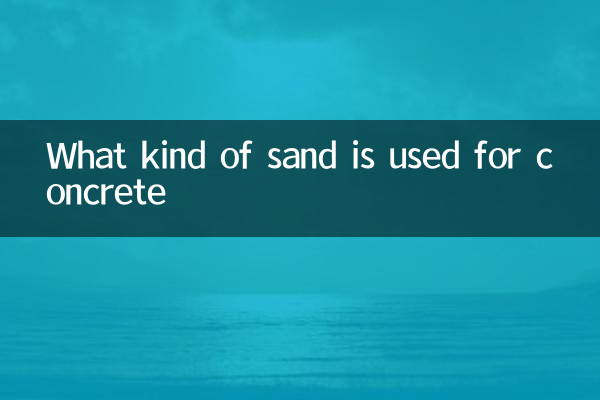What kind of sand is used for concrete? ——Comprehensive analysis of the types and standards of building sand
Concrete is an indispensable material in construction projects, and as one of the important aggregates of concrete, its quality directly affects the strength and durability of concrete. This article will focus on the theme of "What kind of sand is used for concrete", combine the popular topics and hot contents of the entire network for the past 10 days, analyze the classification, standards, performance comparison, etc. of sand, and provide structured data for reference.
1. The main types of concrete sand

According to the source and characteristics, concrete sand is mainly divided into the following categories:
| Types of sand | source | Features |
|---|---|---|
| Natural sand | River sand, lake sand, mountain sand | Round particles, low mud content, suitable for high-strength concrete |
| Machine sand | Rock crushing processing | There are many edges and angles of the particles, so the content of stone powder needs to be controlled |
| Recycled sand | Construction waste recycling | Environmentally friendly but requires strict treatment of impurities |
2. Technical standards for concrete sand
According to the national standard "GB/T 14684-2022 Construction Sand", concrete sand needs to meet the following key indicators:
| Metric Name | Technical requirements | Detection method |
|---|---|---|
| Fine Module | 2.3-3.0 (Medium Sand) | Screening analysis method |
| Mud content | ≤5.0% (concrete above C30) | Rinse method |
| Ruggedness | ≤8% (soaked in sodium sulfate solution) | Soaking test |
3. Recent hot topics: Controversy over the replacement of natural sand by machine sand
Recently, with the increasing scarcity of natural sand resources, the application of mechanical sand has become a hot topic of discussion in the industry. The supporter believes that the machine sand has the following advantages:
1. The source of raw materials is stable and not subject to geographical restrictions
2. The particle grading can be controlled by adjusting the production process
3. The price is usually 20-30% lower than natural sand
The opposition pointed out the main problems of the current machine sand:
1. The stone powder content in some enterprises exceeds the standard (>10%)
2. Poor particle shape leads to a decrease in concrete and ease
3. Environmental protection issues during production
4. Price comparison of different types of sand (latest data in 2023)
| Sand type | area | Price (yuan/ton) | Changes month-on-month |
|---|---|---|---|
| River sand (medium-coarse) | Yangtze River Delta | 120-150 | +5% |
| Machine sand (Class II) | Pearl River Delta | 80-100 | Stay flat |
| Recycled sand | Beijing-Tianjin-Hebei | 60-80 | -3% |
5. Expert advice: How to choose the right concrete sand
1.Strength requirements:High-quality machine sand can be considered for concrete below C30; natural sand is recommended for concrete above C50
2.Economic considerations:When the transportation distance exceeds 100km, machined sand has more price advantages
3.Sustainability:Government encourages projects to give priority to the use of recycled sand
4.Quality Control:On-site inspection must be carried out, focusing on testing mud content and grading
6. Future development trends
According to industry analysis, the concrete sand market will show the following trends in the next five years:
1. The market share of machined sand is expected to increase from the current 45% to 60%.
2. Intelligent sorting technology will improve the quality of recycled sand
3. Sea sand desalination technology may break through regional restrictions
4. The reform of sand and gravel resource tax will affect the price system
Conclusion: Choosing suitable concrete sand requires comprehensive consideration of multiple factors such as performance, cost and sustainability. It is recommended that the engineering construction party make scientific decisions based on specific project needs and combined with the latest industry standards and technological development.

check the details

check the details